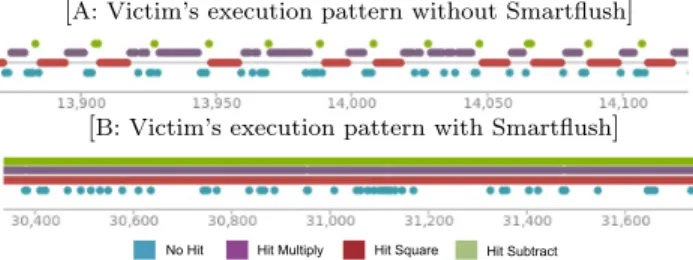HAL Id: hal-01748057
https://hal.archives-ouvertes.fr/hal-01748057
Submitted on 30 Mar 2018
HAL is a multi-disciplinary open access
archive for the deposit and dissemination of
sci-entific research documents, whether they are
pub-lished or not. The documents may come from
teaching and research institutions in France or
abroad, or from public or private research centers.
L’archive ouverte pluridisciplinaire HAL, est
destinée au dépôt et à la diffusion de documents
scientifiques de niveau recherche, publiés ou non,
émanant des établissements d’enseignement et de
recherche français ou étrangers, des laboratoires
publics ou privés.
Improving Confidentiality Against Cache-based SCAs
Maria Mushtaq, Vianney Lapotre, Guy Gogniat, M Mukhtar, Muhammad
Khurram Bhatti
To cite this version:
Maria Mushtaq, Vianney Lapotre, Guy Gogniat, M Mukhtar, Muhammad Khurram Bhatti.
Improv-ing Confidentiality Against Cache-based SCAs. ACM WomENcourage, Sep 2017, barcelona, France.
�hal-01748057�
Improving Confidentiality Against Cache-based SCAs
Maria Mushtaq, Vianney Lapotre, Guy Gogniat
Lab-STICC, University of South Brittany
Lorient, France
{maria.mushtaq, vianney.lapotre,guy.gogniat}@univ-ubs.fr
M. Asim Mukhtar, Muhammad Khurram Bhatti
ECLab, Information Technology University
Lahore, Pakistan
{asim.mukhtar, khurram.bhatti}@itu.edu.pk
ABSTRACT
Side channels and covert channels can give untrusted applica-tions access to the trusted and sensitive data in order to retrieve private information.. In this poster, we present a countermeasure called the Smartflush against cache-based Side Channel Attacks (SCAs). The Smartflush is a quick-patch countermeasure pro-posed to counter timing attacks that exploit inclusive caches in Intel’s x86 architecture. The proposed countermeasure is tested against recent attacks like Flush+Reload. Results show that it improves the confidentiality of data with minimum or no perfor-mance degradation.
Keywords
Cryptography, Side-Channel Attacks, RSA, Countermeasure, Caches.
1.
EXTENDED ABSTRACT
Side-channel attacks are a powerful method for breaking theo-retically secure cryptographic primitives. In recent years, cache-based SCAs have become an eminent threat to cryptographic algorithms, such as RSA and AES, as they cause inter-process information leakage through measurement of timing variations of cryptographic operations and observation of cache access patterns [1], [2]. The success of cache-based timing SCAs mainly depends on two factors: the ability of spy (malicious) process to detect and synchronize itself with the target (victim) process and the pres-ence of page sharing mechanisms like Transparent Page Sharing (TPS) or Kernel Same-page Merging (KSM). A recently proposed timing SCA, Flush+Reload [2], exposes these vulnerabilities on Intel’s x86 architecture by exploiting its inclusive caches. The attack targets RSA cryptographic algorithm’s exponentiation by squaring implementation, which uses a specific pattern of Square, Multiply, and Subtract operations. The attack uses clflush struction to evict selected cache lines corresponding to these in-structions from Last Level Cache (LLC). Due to inclusivity, the instructions are evicted from all other levels as well. The attack then reloads the same cache lines after a prefixed wait time to monitor the timing variations and determines whether the tar-geted instruction is present in the cache (thus being used by the victim process) or loaded from the main memory. Flush+Reload attack affects the confidentiality by disclosing memory addresses of cryptographic operations performed by RSA.
Our poster presents a countermeasure, called Smartflush, to improve confidentiality of cryptographic operations against F lush+
Permission to make digital or hard copies of all or part of this work for personal or classroom use is granted without fee provided that copies are not made or distributed for profit or commercial advantage and that copies bear this notice and the full cita-tion on the first page. Copyrights for components of this work owned by others than ACM must be honored. Abstracting with credit is permitted. To copy otherwise, or re-publish, to post on servers or to redistribute to lists, requires prior specific permission and/or a fee. Request permissions from permissions@acm.org.
WomENcourage, September 6-8, 2017 Barcelona, Spain
c
2017 ACM. ISBN 978-1-4503-2138-9. DOI:10.1145/1235
Reload and similar cache-based timing SCAs. These attacks ob-serve timing variations, i.e., difference between cache hit and miss times, generated by the instructions of targeted operations. Based on these variations, the spy process captures the precise execution pattern of victim process. We propose a mechanism to confuse the spy process to a degree that the effort required to extract use-ful information (i.e., execution pattern of victim) becomes com-parable to the brute force attack. We introduce the concept of so-called Noise process to be run in parallel to spy and victim pro-cesses. Noise process itself does not add any computational over-head. Rather, it only compliments the victim process in hiding its operational details from spy process. Noise process is respon-sible for generating additional memory accesses (called positive noise in this case) or additional evictions (called negative noise in this case) on selected instructions, i.e., square, multiply, and subtract. Since the spy process extracts execution pattern based on these operations as shown in Figure 1(A), therefore, the noise process uses various combinations of positive and negative noise on different instructions in order to confuse this pattern as shown in Figure 1(B).
[
A: Victim’s execution pattern without Smartflush]
[
B: Victim’s execution pattern with Smartflush]
No Hit Hit Multiply Hit Square Hit Subtract
Figure 1:
Zoomed view of victim’s execution patterns extracted by Flush+Reload with and without Smartflush The poster will present our experimental results obtained on an Intel Xeon E5 − 2643 processor by generating 10, 000 requests to web-server sequentially and provide a quantitative and qualita-tive analysis of confidentiality and performance. Our experiments show that Flush+Reload attack cannot extract execution pattern anymore in the presence of Smartflush as the confidentiality is im-proved substantially with minimum or no performance degrada-tion. Moreover, Smartflush can be used as a quick patch counter-measure in user-space without any algorithmic and architectural modifications. Our poster will also present a categorization of countermeasures for cache-based timing SCAs.2.
REFERENCES
[1] Q. Ge, Y. Yarom, D. Cock, and G. Heiser. A survey of microarchitectural timing attacks and countermeasures on contemporary hardware. J. of Crypto. Engg., pp 1–27, 2016. [2] Y. Yarom and K. Falkner. Flush+reload: A high resolution,
low noise, l3 cache side-channel attack. In Proceedings of the 23rd USENIX Conference on Security Symposium, pages 719–732, USA, 2014.
